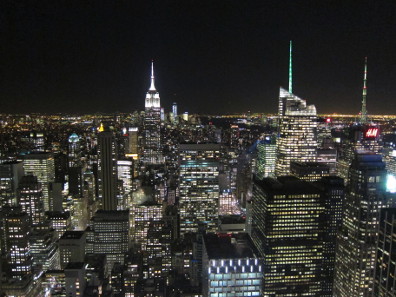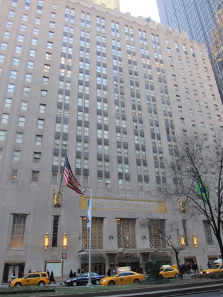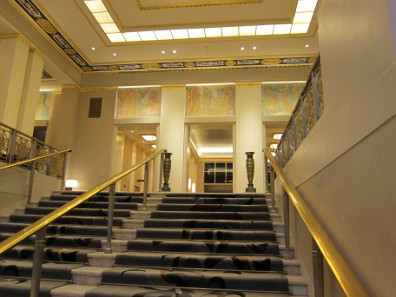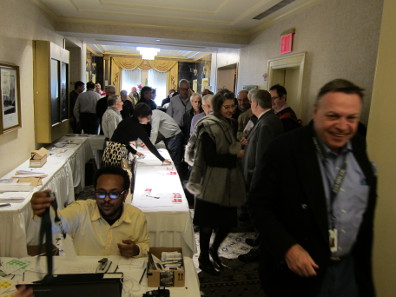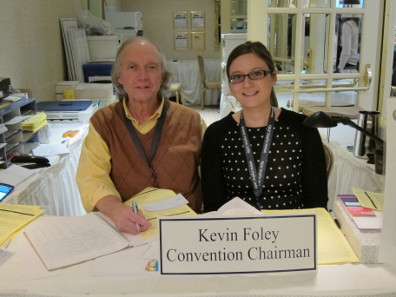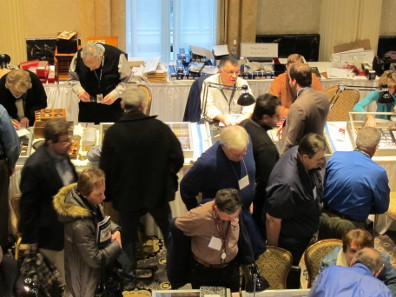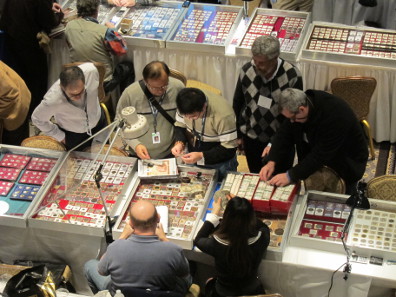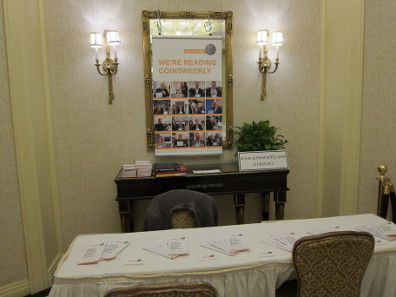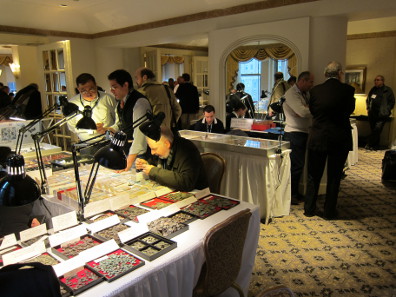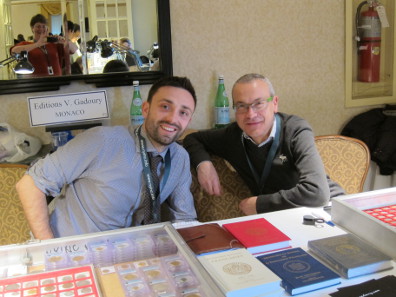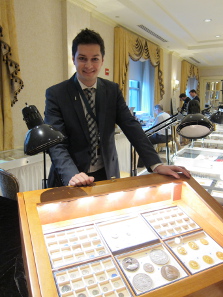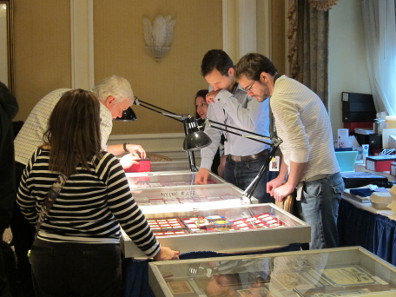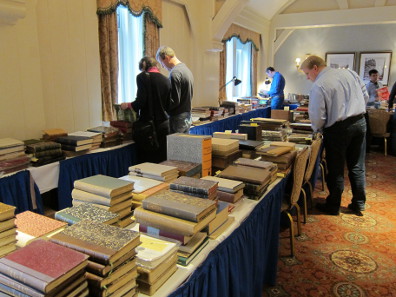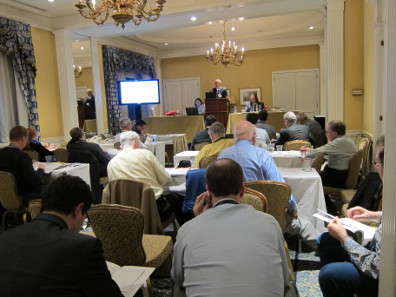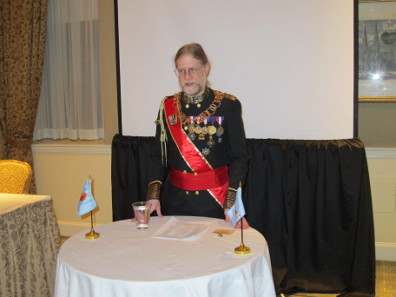by Ursula Kampmann
January 23, 2014 – American coin fairs really do not have much in common with the fairs we get to attend in Europe. American coin fairs are never just about buying and selling but about providing various attractions for collectors and dealers. There are plenty of things to do for you at an American fair: talks, society get-togethers, auctions and exhibitions. What’s more, the New York International has developed into the most luxurious edition of all the fairs in the past decades – and not only since the event has been moved to the Waldorf Astoria.
The Empire State Building viewed from the Rockefeller Center. Photo: UK.
It all started with the idea to create an exclusive environment where demanding customers could buy coins. That is why, for years, the New York International took place during the pre-Christmas time when Manhattan attracts hundreds of thousands of visitors with its festive illumination and thousands of shops. Coin dealers cursed the prices for board and lodging. The collectors’ wives loved it. And then 9/11 changed everything. The New York International, too, had been taking place in the World Trade Center.
The entrance of the Waldorf Astoria. Photo: UK.
The attacks almost put an end to the New York International. But resourceful organizers found a solution to the problem. There was no way to keep the date. In the weeks before Christmas, there simply was no suitable venue available at a reasonable price. However, January has always been a relatively quiet month in New York. And so it happened that the event now takes place a month later than it used to and opens the new (numismatic) year in the prestigious Waldorf Astoria New York.
Staircase. Photo: UK.
Today, the Waldorf Astoria belongs to Hilton Hotels & Resorts. The Art Déco hotel was built in 1931 and is a genuine pleasure for lovers of architectural splendour. The grand staircase in the entrance hall alone is impressive, even if hotel guests carrying heavy luggage (which coin dealers frequently are) prefer the low profile back entrance which has an escalator leading up to the lobby.
The lobby with its famous clock. Photo: UK.
The lobby truly is the heart of the house, especially because of the Wi-Fi which saves you the exorbitant price you would otherwise pay for internet access in your room. So visitors of the New York International make themselves at home in the lobby’s comfortable chairs from morning to night to check their emails. If you forgot to make plans for dinner at the fair, you would simply come downstairs shortly before 7pm. That’s when everybody meets in the lobby – and with a little patience you would always find someone or other you knew.
Elevator doors with decoration. Photo: UK.
To get to the actual fair, you had to use a lift which took you up to the 18. floor.
Registration for the New York International. Photo: UK.
And that’s not all. All visitors were registered and received their identification badge which served as ticket and name tag in one before they were allowed to enter the fair. Dealers and “early birds” were even given photo-IDs.
The “early birds” take the floor. Photo: UK.
The idea behind the “early bird” originated in the U.S.: many dealers claim that they make the best deals while others, who are only just arriving from all over the world, are still busy unpacking their goods. That’s the time to get hold of the amazing bargain, the one under-priced item which makes the whole trip worth it. And to get in people are willing to pay $100 each – ten times as much as for regular tickets.
Two generations of coin fair organizers: Kevin Foley and his daughter Patricia. Photo: UK.
The man in charge is Kevin Foley, who has been running the event for some 15 years. With his calm and dignified manner, he takes care of even the most nervous coin dealers about to make a fuss about a missing lamp/ show case/ table cloth etc. His passionate enthusiasm has even convinced his daughter to join the business, although she originally studied law. He should be proud of himself. Since 2012, Patricia Foley has been responsible for the Central States Numismatic Convention. And the New York International has no reason to worry about its future organisation either.
The Starlight Roof. Photo: UK.
The Starlight Roof is the room where most of the action takes place; “starlight” because years ago, the glass roof which covered the hall offered a view of the night sky. By now, electric light has eclipsed the starlight and the Waldorf Astoria’s former glass roof has been substituted by a ceiling when another five stories were added to the building. Despite all that, the hall has kept some of the splendour from its heyday. Since the 50s, the sons and daughters of the rich and famous celebrate themselves at the debutant ball which is held in this room. Daughters of presidents, of the Rockefellers’ and Vanderbilts’, of the House of Habsburg and Bismarck come out here for the first time.
Starlight Roof on Friday morning. Photo: UK.
From January 9, 2014, to Sunday 12, 2014, however, the place belonged wholly to coin collectors and dealers from all over the world.
Starlight Roof on Friday morning. Photo: UK.
Getting a table at the New York International truly isn’t easy. The waiting list is very, very long. From time to time a table becomes available, but newcomers are not given a place in the Starlight Roof. They are assigned to one of the smaller rooms, which, admittedly, are as busy as the main room.
The booth of CoinsWeekly. Photo: UK.
All the more reason for us to be proud to get a table directly at the entrance! Sadly, the happy occasion was the result of an unfortunate precedent. The place used to be occupied by Kerry Wetterstrom, from the Celator, who had decided to shut down the magazine after having suffered from a serious illness. What a happy sight it was when Kerry, who is much better these days, came over to pay his compliments to CoinsWeekly! In general, it was a pleasure to see just how many followers our weekly newsletter has in the U.S.
The Palm Room. Photo: UK.
There were three additional rooms, which together hosted as many dealers as the Starlight Roof.
Fred Pastrone from Monaco and LLuis Lalana of Aureo i Calicò from Barcelona. Photo: UK.
The exhibitors were very international. Apart from the American companies, which – unsurprisingly – made up more than half of the participants, the most active and renowned coin dealers from all over the world were present.
Extremely popular: the booth of Künker. Photo: UK.
Although many German dealers attended the fair, only three major auction houses actually had a booth: Gorny & Mosch, Künker and Harald Möller from Espenau.
Yves Gunzenreiner / Nomos. Photo: UK.
Switzerland, on the other hand, was represented by six businesses altogether, among them Yves Gunzenreiner from Nomos, who proudly presented his merchandise. And if anyone thought coin trade was lacking new blood, they would soon be proven wrong.
James Ricks and his colleague from Atlas Numismatics. Photo: UK.
James Ricks, for instance, is not just famous among young numismatics for his legendary parties but also for the interesting coins he sells – and he doesn’t get tired of emphasising that 😉
Many dealers arrive a week early in order to inspect the auction lots. Photo: UK.
At the New York International, six major international auction houses hold their auctions: Heritage, CNG, Stacks-Bowers-Ponterio, Gemini and Kolbe & Fanning, not to forget the New York Sale organized by Baldwin, Dmitry Markov and M&M Numismatics. Every year yields new record prives. I won’t go into detail here as you can read all about it in the follow-up reports on the auctions.
A glance at the viewing room of the Kolbe & Fanning auction. Photo: UK.
All under one roof and on the same floor: each company has their own room where the auction lots can be viewed and collected after the auction.
Kolbe & Fanning auctioneer the library of Herb Kreindler. Photo: UK.
For years, Herb Kreindler was the busiest man in New York. He auctioned for more firms than anybody else. This time, however, his own library was being auctioned by Kolbe & Fanning.
A look at the programme. Photo: UK.
Saturday usually offers a great variety of interesting lectures by renowned numismatists.
Alanus I., King of Bermania. Photo: UK.
The rather entertaining last event was, as per usual, the meeting of Be.G.O.N, the Bermanian Guild of Numismatists. Be.G.O.N. is the royal numismatic society founded by Alanus I., self-declared king of the infamous Kingdom of Bermania, whose lost past has to be reconstructed from non-existent sources with a lot of effort. This year, the king gave a speech on the subject of the first Jesuit in Bermania, whose seven statues in honour of the seven virtues were not much of a success as Bermania’s cardinal virtue – humour – was missing.
This brings us to the end of our visit of the New York International. I recommend a visit to anyone who is interested in ancient and world coins. You are going to discover a whole new world of numismatics. A world which even provides chairs at the dealers’ tables so that dealers and collectors can have long conversations. A world, where famous collectors, whose collections have been published as standard works, mingle with completely “ordinary” collectors. A world of glitz and glamour, humour and numismatic friendship. A world that brings visitors from all over the world again and again to New York every year.
The next New York International will be taking place from January 8 to 11, 2015.
And if you are curious about numismatics in New York: next week, CoinsWeekly will report on the ANS, the American Numismatic Society.
Further useful websites:
Watch out for special offers in connection with the fair. The required booking number is available on the website of the New York International.
If you’re interested in having a booth on the New York International, please get in contact with Kevin Foley.
And even the Kingdom of Bermania has its own website.





